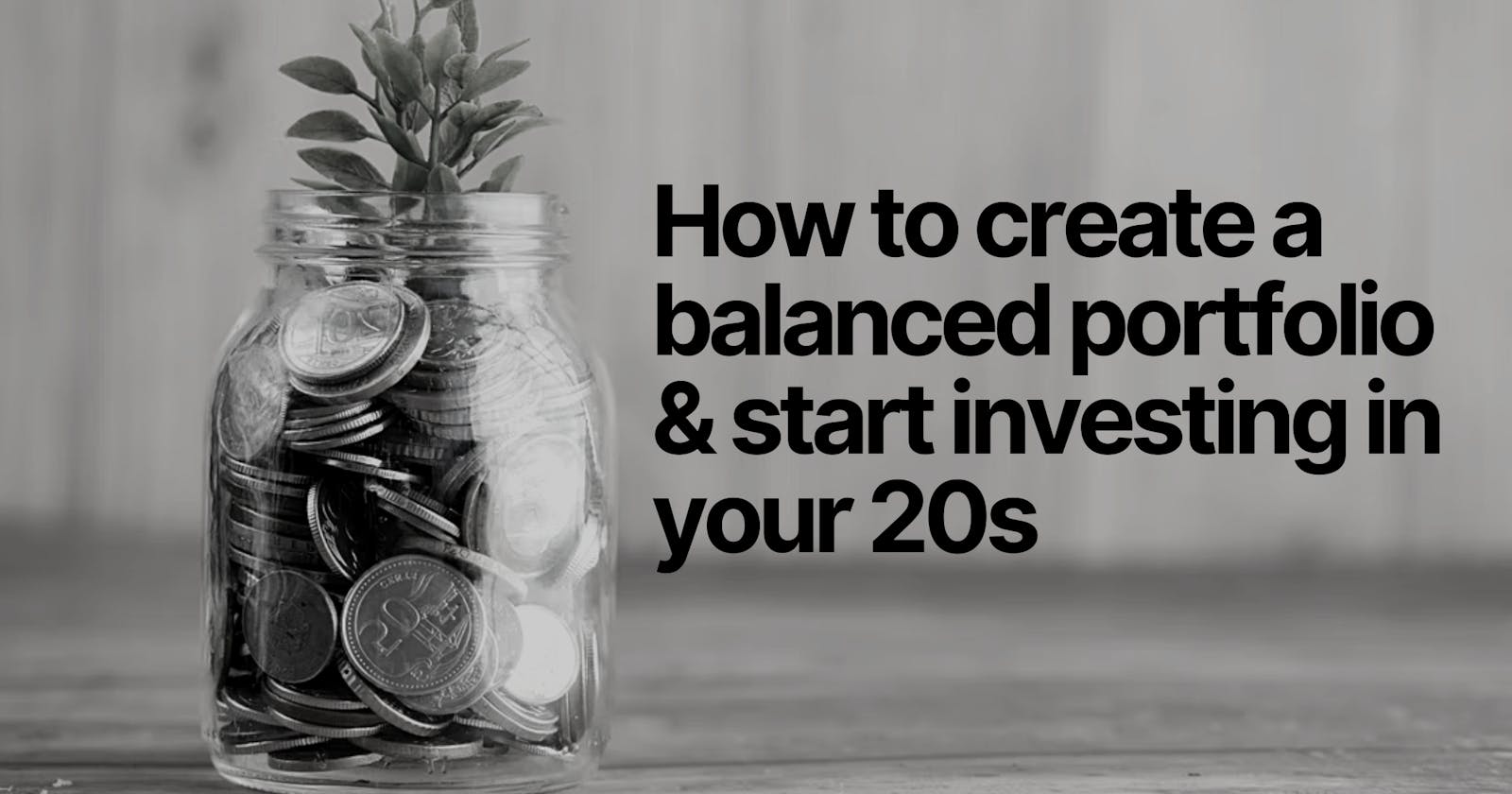While in the last post, we learnt about why to invest and where to invest, we had unanswered the question - How to Invest?
In this post we will learn about, how you can create a balanced portfolio for yourself and will also answer major doubts like -
- Prerequisites of investment
- How to decide the amount to invest
- Which assets to invest in
- How to diversify your portfolio
So without any further ado let's begin.
Prerequisites of Investment
Before you start to invest, you must have these 3 things covered or else you can be in a deep trouble later.
Consider these as an essential checklist that needs to be completed before starting your investment journey
Before starting any kind of investment you must have
- Health Insurance
- Life Insurance
- Emergency Fund
Why I need all this?
1. Health Insurance
As it is a type of insurance that covers your medical expenses that may arise due to an illness. God forbid if someday you need to pay hospitalization costs, or even doctor consultation fees which are at peak in last 2 years due to covid - you need to have an health insurance policy, to ensure your financial security.
It is suggested to have a seperate health insurance policy for both yourself and your family
2. Life Insurance
If you are a sole earner in your family then your life might be much more valuable than you think, for your family.
God forbid if something happens to you like - unlikely death or a critical illness, your family might come under a tight situation if you weren't insured.
Term plan is the best plan - where you can get highest coverage by paying lowest premium. Ideally your cover should be 20-25x your annual salary.
For eg. if you are earning 5L/year your cover should vary from 5L 20 to 5L 25 = 1Cr/- to 1.25 Cr/-.
3. Emergency Fund
You create an emergency fund to financially secure yourself from situations where consider you were unemployed for a short period of time.
If you gone under an sabbatical or an operation - simply putting whatever an emergency you go through, you should've an emergency fund backed up.
Emergency Fund should cover up your basic monthly needs(not wants or desires). Nahh - That sexy looking new smartphone doesn't come under it. It should cover your housing expenses, food bills etc.
An ideal emergency fund should be 6x to 12x your expenditure on monthly needs. Suppose I need 20k a month to basically survive, my emergency fund should be ideally around 6 20k = 1.2 Lac to 12 20k = 2.4 Lac.
Where to put money of emergency fund?
You can split your emergency fund money into 3 parts 70% -> into Fixed Deposits 20% -> into your Bank Account(Savings Account) 10% -> Liquid Cash
How to Start Investing
1. Decide the money you'll be investing
The 50-30-20 Rule of Budgeting
50% in needs - The 50-30-20 rules says that 50% of your income should go into your monthly needs(not wants) -> your food, your EMI
30% in wants - 30% of what you earn should go into your wants. That new smartphone that you want to buy, that trip to Goa that you always wanted to complete, those desires fall under this category.
20% in INVESTING - 20% of what you earn should strictly be invested every single month.
Wait, then how do I complete my desires?
You might be thinking by such divison of money, how can I fulfill my desires. That new phone I want to buy cost me 45k. And all I earn is 50k, so according to this rule - 30% of my money should be going in my wants - I am allowed to spend only 30% of 50k which is only 15k into my wants.
Exactly - by following this rule, you will come to know that, a new 45k phone isn't costing me 45k, it's costing me 3 months of my hardwork(3 * 15k(30% of my assumed income)), and its less likely that you would still want to buy that new phone.
2. Put your money - into different asset classes
The need of diversifcation
We all have heard this, never put all your eggs in one basket. Ever asked, why? Here is a simple answer - If let's say I put all my eggs in one basket - say I buy a stock that Elon Musk tweets about and put all my savings into it. The next day I wake up, anything could've potentially happened to that stock.
Either it had gone up, or potentially also the possibility of going down still existed - so it might've gone down too.
Imagine a scenario where you put all your eggs in one basket and the next day that basket fell from the roof. Nobody would like to endup in such a scenario, so we have a need of diversifying our portfolio into different asset classes.
Age is not just a number
Your age is a very strong proxy for the kind of risk you can take. If you are young, you are 25, you can take much more risk than a 50 year old can. That doesn't mean you love to take risk, that means if your portfolio has gone into a loss, you still have enough years of time to recover from it.
Diversify your portfolio according to your age
Here is an ideal way of diversifying your portfolio.
If your age is X, than (100 - X)% of your investments can be in risky assets
By risky assets I don't mean you will be gambling around, but the assets would be more volatile(High risk, high returns).
If you ignore short term volatility, than over a long period of time risky assets can give you a pretty nice amount of return.
On the other hand while stable assets give you a predictable return, it's not much handsome. But it is necessary for financial security.
Decide your investments according to your age
If your age is 25, 75% of your money should go into risky assets, and 25% of your money should go into stable assets.
On the other hand if your age is 45, 65% of your money should go into risky assets, and 45% of your money should go into stable assets.
Which are the stable assets
1. Tax Saving Funds
First things first we will be investing in tax-saving assets. Your stable assets should be covered with your tax-saving funds like EPF, PPF, NPS, ELSS etc.
Even after investing in these tax saving funds you still have some money left,
2. Gold
You can invest into Gold. Gold is a fairly good stable assets, that can give nice amounts of returns over time.
Don't buy gold in jewellery format - buy it in digital format - ie. you can buy sovereign gold bonds. Govertment releases SBG every quarter. Along with gold appreciation you get 2.5% of increased returns on these bonds, so its a fairly good stable investment
Gold over the last 30 years has given an average CAGR(compounded annual growth rate) of 8%. Adding 2.5% returns of SGB, you can get around 10% returns every year which can be quite handsome.
3. Real-Estate
It is suggested to invest in real-estate only in your 30s or 40s.
It's not something you should invest in your 20s.
Because real-estate has never beaten stock market in terms of return over the past years. And it requires a huge amount of money to begin with too.
It is suggested to invest in commercial real estates only which can give you rental yield.
Risky Assets
1. Equity Markets
Stocks - You can invest in stocks by buying stocks directly - only if you know how to research.
If you want less headaches and don't want to spend your time in researching(it does require a lot of time) you can buy index mutual funds and do SIP in them. Almost every bank has an index mutual fund.
Other than mutual funds you can buy smallcases - smallcase represents an idea or a strategy, which bet on a short momentum of stocks and can give you high returns - but also comes with high volatility.
2. Cryptocurrency
Only invest in crypto, if you understand it. It is not a money minting machine and NO - blockchain doesn't create infinite money, that is rewarded to you.
Before investing in crypto its good to know about the basics of blockchain and web3 and also the basics of investing -> having a proper mindset. Don't invest in crypto out of FOMO and only invest in renowned coins.
Conclusion
In summary, your age is the most important determinant. The 50-30-20 rule will determine the amount you should be investing, and that money will be again split into risky and stable investments
100 - X(your age)% of your investment money, will go to risky assets - direct stocks, MFs, smallcase, crypto etc
X% of your money will go into stable assets - Tax saving schemes, Gold(SGB) and Real estate - only after your 40s
No matter what your age is, you can start investing today. Never say I'm late to the journey. The worst thing that you can do is I'm late, you're not late but every single day that you do not invest is a day you are not letting compounding take over your investments.

